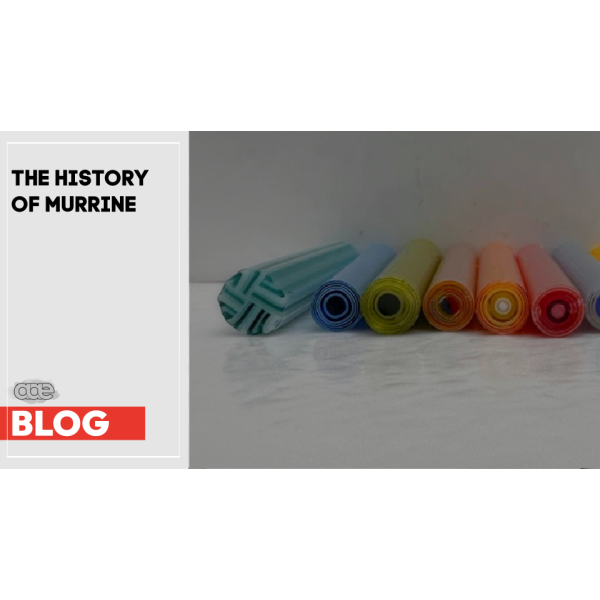
The History of Murrine
The Mesmerizing History of Murrine Glass — From Ancient Origins to Modern Kilns
If you’ve ever held a tiny slice of patterned glass in your hand — maybe a flower, a spiral, or a starburst — you’ve likely met murrine glass. These colorful cross-sections are more than just decorative; they carry a rich legacy in glass art history that stretches back over 2,000 years.
Today, artists use murrine in fused glass jewelry, kiln-formed panels, and even large-scale installations. But where did this captivating technique come from, and how did it evolve into a modern fused glass essential?
What Is Murrine Glass?
Murrine (also spelled murrina) is a glassmaking technique where different colors of molten glass are layered, stretched into rods (called glass canes), and then sliced to reveal intricate patterns inside. Think of it like a jelly roll made of glass — every slice tells a visual story. These cross-sections can be floral, geometric, abstract, or even portrait-based, depending on the artist’s vision.
You’ll often see murrine glass used in:
-
Fused glass projects
-
Glass dot earrings
-
Millefiori beads and vessels
-
Decorative inlays in blown or kiln-formed glasswork
Ancient Origins & Venetian Revival
The earliest known murrine can be traced back to ancient Rome, Egypt, and Alexandria, where glassmakers created tiny mosaic-like images embedded in bowls and vessels. These early examples were often symbolic, decorative, and incredibly detailed — made without modern tools or torches.
But it was during the Venetian Renaissance, particularly on the island of Murano, Italy, that the technique was reborn. Murano became the heart of the millefiori glass movement — literally “a thousand flowers.” This style used murrine techniques to produce stunning floral patterns in glass beads and paperweights, which became internationally sought after.
The Modern Studio Glass Movement
The revival of murrine in the 20th century came through the hands of iconic studio glass artists like Richard Marquis, Dante Marioni, and Lino Tagliapietra, who blended traditional Venetian methods with modern storytelling and experimentation. Another name to be mentioned is Nathan Sandberg, who is considered a pioneer of Bullseye glass murrine techniques in today's glass art community.
These artists used murrine canes to make abstract portraits, political commentary, and sculptural glasswork that broke the boundaries of what “decorative” meant in the art world. Their work laid the foundation for contemporary fused glass artists to adopt murrine in fresh, bold ways.
Murrine in Fused Glass Today
In today’s kiln-formed world, Bullseye murrine glass is one of the easiest ways to add color, detail, and depth to a piece. Artists no longer need to pull their own canes — pre-made Murrine can now be purchased at aaeglass.com and come in brilliant patterns like Starfire, Rainbow Sherbert, and Concentric Circles.
💡 Pro Tip from Tanya:
Snip a 1/4" to 3/8" slice of murrine, fire it in a kiln, and watch it bloom into a perfect, glossy dot. Pair it with our dot earring settings, and you’ve got an instant gift or product to sell! Read full tutorial below.
Whether you’re making jewelry, layering in landscapes, or using murrine slices as focal points, the possibilities are endless — and the results are always visually rich.
Why Glass Artists Love Murrine
Here’s why premade murrine is more popular than ever among fused glass artists:
-
Instant visual pop — A small slice adds incredible depth and color
-
Beginner-friendly — No torch or cane-pulling required
-
Endlessly versatile — Use in earrings, pendants, plates, bowls, or mosaics
At AAEGlass.com, we stock exclusive patterns of Bullseye murrine glass, carefully curated and kiln-tested to guarantee beautiful results for your projects.
Where to Start
Whether you’re just starting or rediscovering glass fusing, murrine is a fun, accessible, and powerful technique. It blends history, color theory, and creativity — all in one tiny slice.
🎯 Ready to dive in?
-
Shop Bullseye Murrine Glass at AAEGlass.com
-
Watch Tanya’s Free Murrine Dot Tutorial
-
Join the AAE Glass Membership for 120+ Tutorials
- Read the easy-to-follow tutorial below for Murrine Dot Earrings
Easy Dot Earring Tutorial with AAE Glass Murrine
Create Gorgeous Fused Glass Earrings in Just a Few Simple Steps!
Step 1: Mark & Snip
Using a ruler and a black Sharpie, mark 1/4" increments down the length of your murrine stick.
Grab your tile nippers and carefully snip the entire stick into sections. These will become your dot earrings—the more you snip, the more pairs you can make!
Tip: Snip the whole stick while you're at it. Trust me, you’ll want extras.
Step 2: Clean & Arrange
Clean your murrine pieces thoroughly, then space them about 1" apart on a kiln shelf that’s been prepped with kiln wash and topped with a sheet of ThinFire paper.
Why ThinFire? It prevents kiln wash from sticking to the bottom of your glass. If any residue does sneak in, use Wash-Away (a studio must-have!) to clean it off.
Step 3: Full Fuse Fire Schedule
This quick fuse is perfect for murrine-only firings:
- 600°F per hour to 1500°F
- Hold for 15 minutes
- Turn the kiln off — no need to anneal!
⚠️ Important: Use this firing schedule only when fusing murrine or single-layer dichroic dots. It’s not suitable for multi-layer projects...(continued next page.)
Step 4: Match & Mount
After fusing, you’ll notice some slight variation in dot size (thanks to the handmade nature of pulled murrine — it's part of the charm!).
Match similar-sized dots into pairs and glue them into aaeglass’ versatile round stud earring settings (item# ER-03 @ aaeglass.com) using E6000+ (yes, the plus version!).
Let them dry for 24 hours, and you’re done!
That’s It — You’re a Dot Earring Pro!
You now have a one-of-a-kind fused glass gift for yourself or someone you love.
Selling at shows? These will be your bread and butter, baby! Easy to make, affordable, and they sell like crazy. We hope you have enjoyed this evening’s inspiration.
🚨 The Fuse Squad

Comments
Leave a comment